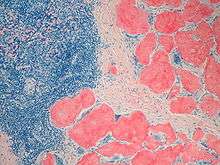Lect2 amyloidosis

LECT2 Amyloidosis, or ALect2, is one of the most recently recognized types of amyloidosis, and is also one of the most common forms, along with AL amyloidosis and AA amyloidosis.[1] Amyloidosis results when there is abnormal deposition of protein in tissue organs, typically resulting in organ failure.
Causes
There are over 30 proteins known to cause Amyloidosis in humans. ALect2 is caused by the deposition of the Leukocyte Chemotactic Factor 2 (LECT2) protein in the kidneys, and typically cause symptoms similar to kidney failure.[1]
Signs and symptoms
LECT2 Amyloidosis presents as progressive renal failure in elderly, Hispanic patients.[2] Associated symptoms may include fatigue, dehydration, swelling of kidneys, and blood in urine.
Some cases may also result in progressive renal insufficiency with proteinuria,[1] as well as chronic renal insufficiency and bland urinary sediment.[3]
Diagnosis
A kidney biopsy is required for definitive diagnosis.
If renal amyloidosis is diagnosed, antibody or proteomic methods are used to type amyloidosis.[1] AL amyloidosis is the most common form of amyloidosis, accounting for 85% of total cases, and can be tested by taking a blood sample. If the patient tests negative for AL, a Congo Red staining of the kidney biopsy will be done to determine if the patient has ALect2.
ALect2 is often misdiagnosed as AL amyloidosis, which is derived from immunoglobulin light chain.[1]
Prognosis

End-stage renal disease is developed in 1 out of 3 patients, and the median renal survival is 62 months.[3] A suggested prognostic tool is to track creatinine levels in ALect2 patients.
Treatment
There currently is no effective treatment for LECT2 amyloidosis.[1]
Risk Factors
Most ALect2 patients in the United States (88%) are of Mexican descent descent, and are from the Southwest region of the United States (New Mexico, Arizona, far Western Texas).[2] However, other groups with higher incidence rates include First Nation Peoples in Canada, Punjabis, Sudanese, and Native Americans.[2][3][4][5][6]
ALect2 cases have been found in patients between 43 and 88, with a mean age of 67.[2][3][5][6][7][8][9][10]
There currently is no familial link in the disease, though there have been several cases described between siblings.[3]
See also
References
- Holanda DG, Acharya VK, Dogan A, Racusen LC and Atta MG. Atypical Presentation of Atypical Amyloid. Nephrology dialysis transplantation.2011; 26(1):373-6.
- 1 2 3 4 5 6 Picken, M. (Aug 2014). "Alect2 amyloidosis: Primum non nocere (first, do no harm).". Kidney Int. 86 (2): 229. doi:10.1038/ki.2014.45. PMID 25079018.
- 1 2 3 4 Larsen, C.P.; Kossmann, R.J.; Beggs, M. L.; Solomon, A.; Walker, P.D. (Aug 2014). "Clinical, morphologic, and genetic features of renal leukocyte chemotactic factor 2 amyloidosis". Kidney Int. 86 (2): 378–382. doi:10.1038/ki.2014.11. PMID 24522497.
- 1 2 3 4 5 Said, S. M.; Sethi, S.; Valeri, A. M.; Chang, A.; Nast, C. C.; Krahl, L. (Aug 2014). "Characterization and outcomes of renal leukocyte chemotactic factor 2-associated amyloidosis". Kidney Int. 86 (2): 370–377. doi:10.1038/ki.2013.558.
- ↑ Dogan, A.; Theis, J.D.; Vrana, J.A.; Jimenez-epeda, V.H.; Lacy, M.Q.; Leung, N. (2010). "Clinical and pathological phenotype of leukocyte cell-derived chemotaxin-2 (LECT2) amyloidosis (ALECT2)". Amyloid: 69–70.
- 1 2 Hutton, H.L.; DeMarco, M.L.; Magil, A.B.; Taylor, P. (2014). "Renal leukocyte chemotactic factor 2 (LECT2) amyloidosis in first nations people in northern british columbia, canada: A report of 4 cases.". Am J Kidney Dis. 64 (5): 790–792. doi:10.1053/j.ajkd.2014.06.017. PMID 25064673.
- 1 2 Murphy, C. L.; Wang, S.; Kestler, D.; Larsen, C.; Benson, D.; Weiss, D. T. (2010). "Leukocyte chemotactic factor 2 (LECT2)-associated renal amyloidosis: A case series.". Am J Kidney Dis. 56 (6): 1100–1107. doi:10.1053/j.ajkd.2010.08.013. PMID 20951486.
- ↑ Benson, M. D.; James, S.; Scott, K.; Liepnieks, J. J.; Kluve-Beckerman, B. (April 2008). "Leukocyte chemotactic factor 2: A novel renal amyloid protein.". Kidney Int. 74 (2): 218–222. doi:10.1038/ki.2008.152. PMID 18449172.
- ↑ Holanda, D.G.; Acharya, V.K.; Dogan, A.; Racusen, L.C.; Atta, M.G. (Oct 2010). "Atypical presentation of atypical amyloid". Nephrol Dial Transplant. 26 (1): 373–376. doi:10.1093/ndt/gfq638. PMID 20940371.
- ↑ Larsen, C. P.; Walker, P.D.; Weiss, D. T.; Solomon, A. (February 2010). "Prevalence and morphology of leukocyte chemotactic factor 2-associated amyloid in renal biopsies.". Kidney Int. 77 (9): 816–819. doi:10.1038/ki.2010.9. PMID 20182418.
- ↑ Said, S. M.; Sethi S.; Valeri, A.M.; Leung, N.; Cornell, L. D.; Fidler, M. E. (May 2013). "Renal amyloidosis: Origin and clinicopathologic correlations of 474 recent cases.". Clin J Am Soc Nephrol. 9 (9): 1515–1523. doi:10.2215/CJN.10491012. PMID 23704299.